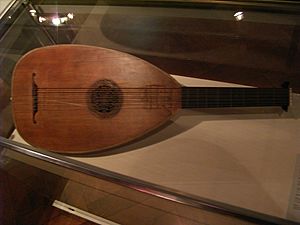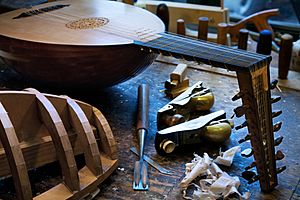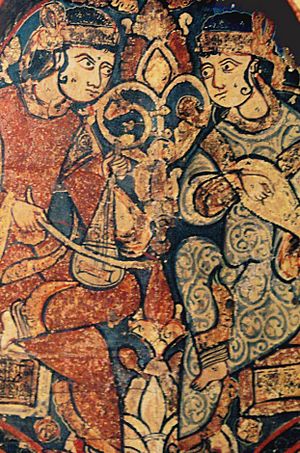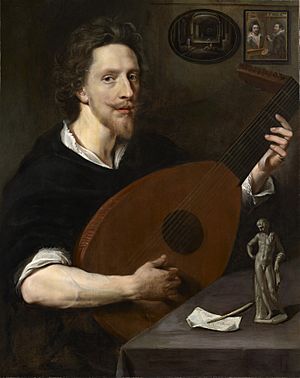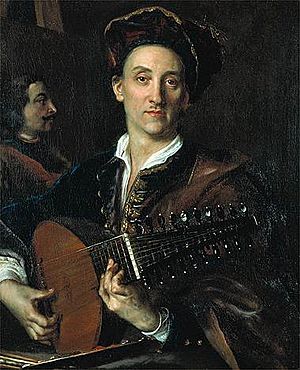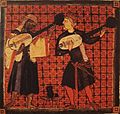Lute facts for kids
The lute is an ancient musical instrument with strings. It looks a bit like a classical guitar, but with a rounder back. The first lutes came to Spain from the Moors and other Arabic lands. The lute is actually one of the ancestors of the modern guitar!
A lute has a special oval-shaped back, made from thin strips of wood glued together. Its front is flat, and a long neck sticks out from it. Early lutes had four strings, or sometimes eight strings arranged in pairs. On the neck, there are strings tied around it called frets. Players press down on the strings against these frets to make different notes.
The flat front part of the lute's body is called the soundboard. It often has a lovely carved hole in the middle, known as the rose.
In the past, people played the lute by strumming or plucking its strings with a pick. Later, musicians learned to play it using only their fingers. During the Renaissance period, bigger lutes were made, often with seven or eight pairs of strings. New types of lutes also appeared, like the theorbo and the archlute.
The lute also influenced other instruments in European classical music, such as the harpsichord and the mandolin. Today, different kinds of lutes are still played in countries like Greece, Turkey, and Arabic-speaking lands. The Renaissance lute is also popular in Western countries, and there's even a German lute played like a guitar.
How is a Lute Built?
Lutes are almost entirely made of wood. Building a lute is a very detailed process.
The Soundboard: Making the Music Ring
The soundboard is the thin, flat, teardrop-shaped piece of wood on the front. It's usually made from spruce wood, which is great for sound. All lutes have a decorated sound hole under the strings called the rose. This hole isn't open; it's covered with a beautiful carved design, like a vine or a knot.
The soundboard's design is quite complex. It has special wooden braces inside that help give it strength and shape the sound. Some builders even adjust the thickness of the soundboard as they work, making sure it sounds just right. The soundboard is rarely painted or varnished, but sometimes it gets a very thin coat of shellac to keep it clean.
The Back: A Rounded Shell
The back of the lute, also called the shell, is made from many thin strips of hardwood. These strips, like maple or rosewood, are glued together edge-to-edge to create the lute's deep, rounded body. Inside, there are also braces to make it strong.
The Neck and Pegbox
The neck of the lute is made of light wood. It has a thin layer of harder wood, usually ebony, on top for the fretboard. Unlike many modern instruments, the lute's fretboard is flat with the top.
The pegbox is where the tuning pegs are. Before the Baroque period, the pegbox was angled almost straight back from the neck. This helped hold the strings tightly against the nut, which is a small piece of wood that guides the strings. The tuning pegs are simple wooden pegs that stay in place by friction. Tuning a lute can be tricky because these pegs don't have gears like modern guitars!
The Bridge: Holding the Strings
The bridge is a small piece of wood, often fruitwood, glued to the soundboard. It holds the strings and transfers their vibrations to the soundboard. The bridge has holes where the strings are tied directly. It's shaped so it's taller and wider for the lower-pitched strings and smaller for the higher ones. Lute bridges often have carved decorations.
Frets: Guiding the Notes
The frets on a lute are loops of gut string tied around the neck. They wear out over time and need to be replaced. Some lutes also have a few extra wooden frets glued to the body for very high notes. Many lute makers prefer using gut for frets because it fits well around the neck.
Strings: The Voice of the Lute
Historically, lute strings were made from animal gut, usually from sheep. Today, they can still be made of gut or a synthetic material like nylon. Lower-pitched strings often have metal windings. Gut strings are more traditional for old music, but they can be affected by humidity. Nylon strings are more stable for tuning.
Lute strings are usually arranged in courses, which means pairs of strings. However, the highest-pitched string, called the chanterelle, is usually a single string. In later Baroque lutes, the top two courses might be single. The courses are numbered from the highest pitch. So, an 8-course Renaissance lute usually has 15 strings (one single, seven pairs). A 13-course Baroque lute can have 24 strings!
The two strings in a course are almost always played together, as if they were one string. However, sometimes a piece of music might ask for them to be played separately. The lute's design makes it very light for its size.
History of the Lute
The lute has a very long and interesting history.
Early Lutes: Ancient Roots
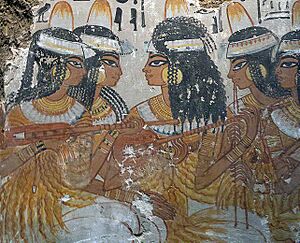
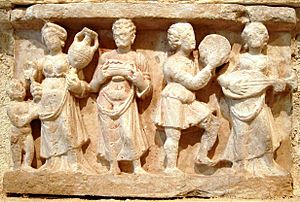
The exact beginnings of the lute are a bit mysterious. Some experts believe that instruments similar to lutes existed in Mesopotamia over 3000 years ago! An ancient cylinder seal from around 3100 BC shows what looks like a woman playing a stick "lute." These very early lutes were often long-necked.
The short, almond-shaped lute developed further east, in areas like Bactria and Gandhara.
From Persia to Europe: The Oud's Journey
This short, almond-shaped lute became known as the barbat in the Sasanian Empire (which was in Persia). Later, it developed into the oud in the Islamic world. When the Moors conquered Andalusia (parts of Spain) in 711 AD, they brought their oud with them.
Many musicians from the Islamic world came to Spain during the 8th and 9th centuries. One famous musician, Abu l-Hasan ‘Ali Ibn Nafi‘ (known as Ziryab), added a fifth string to his oud and started one of the first music schools in Córdoba. By the 11th century, Muslim Spain was a hub for making instruments. These instruments slowly spread across Europe, influencing French musicians and eventually reaching other parts of the continent. While the lute developed in Europe, the oud remained a key instrument in Arab and Ottoman music.
The Lute in the Middle Ages and Baroque Period
Besides Spain, another important place where the lute entered Europe was Sicily. Musicians brought it there from the Byzantine Empire or Muslim lands. Lutes were played at the court in Palermo, Sicily, as early as 1140. By the 14th century, lutes were common throughout Italy and had also spread into German-speaking areas.
Medieval lutes usually had 4 or 5 courses (pairs of strings) and were played with a quill or pick. By the end of the Renaissance, there were seven different sizes of lutes! In the Middle Ages, the lute was probably mostly used to accompany singers. Not much written music for the lute from before 1500 has survived, as accompaniments were often made up on the spot.
Around 1500, lute players started using their fingertips instead of a pick. This allowed them to play more complex music. The number of courses grew to six and even more. The lute became the most important solo instrument of the 16th century, but it still accompanied singers.
By the end of the Renaissance, lutes had ten courses. During the Baroque era, this number kept growing, sometimes reaching 14 courses or more! These instruments, with up to 35 strings, needed new designs. Instruments like the archlute and theorbo had long extensions to make the bass strings longer and deeper. Because there were so many strings, the bass strings were placed off the fretboard and played open (without pressing them down).
During the Baroque period, the lute was increasingly used for background accompaniment and was eventually replaced by keyboard instruments. After 1800, the lute almost disappeared, though some types were still used in Germany, Sweden, and Ukraine for a while.
The Lute Today
The lute has become popular again since the early 1900s, thanks to a growing interest in historical music. Famous pioneers in this lute revival include Julian Bream and Diana Poulton. Now, it's not unusual to hear lute performances, and many professional lutenists play around the world. New music is even being written for the instrument!
In the early days of the "early music" movement, many lutes were built by people who usually made classical guitars. These lutes were often too heavy and built differently from historical lutes. But as experts learned more, builders started making lutes that were exact copies or very close to the original historical instruments found in museums. These new lutes are lighter and sound better.
Today, most lutes are replicas of historical instruments. Many are custom-made, but you can also buy them from specialized builders or find them second-hand. Because the market is smaller than for guitars or violins, lutes can be more expensive than mass-produced modern instruments.
There are many types of lutes played today:
- 5-course medieval lutes
- Renaissance lutes (6 to 10 courses) for solo and ensemble music
- Archlutes for Baroque music
- 11-course lutes for 17th-century French, German, and Czech music
- 13/14-course German Baroque lutes for later Baroque and Classical music
- Theorbos for bass parts in Baroque groups
- Other instruments like gallichons, mandoras, and orpharions
Lute playing has reached high levels of skill recently, thanks to many world-class lutenists. Even famous singer-songwriter Sting has played the lute and archlute!
Lutes are also still common in Greece, where they are called laouto and outi.
Images for kids
-
An Ancient Greek statuette from the 2nd century BC, showing a player of the pandura, an early stringed instrument.
-
Orazio Gentileschi's painting from around 1626, showing a young lutenist playing a 10-course lute.
See also
 In Spanish: Laúd para niños
In Spanish: Laúd para niños


